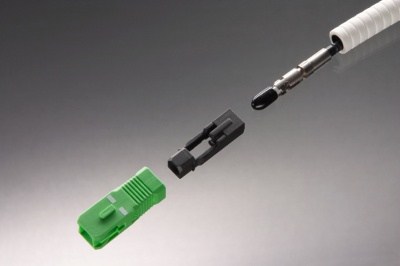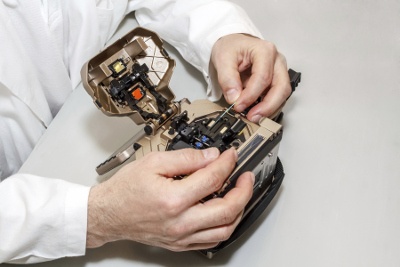 Fitting connectors to fiber optic cables in the field is a complex and highly specialized task. It is easy for dust and dirt to contaminate connectors, blocking the optical signal and leading to light loss, reducing power and efficiency. It is also a delicate process requiring dexterity and high attention to detail. In some instances, the cable has to be scrapped, and the process started again if the fiber performance is not satisfactory.
Fitting connectors to fiber optic cables in the field is a complex and highly specialized task. It is easy for dust and dirt to contaminate connectors, blocking the optical signal and leading to light loss, reducing power and efficiency. It is also a delicate process requiring dexterity and high attention to detail. In some instances, the cable has to be scrapped, and the process started again if the fiber performance is not satisfactory.
Consequently, field splicing connectors has become a highly specialized art, requiring highly skilled staff armed with expensive fiber splicing equipment. As fiber network rollouts accelerate, this approach is simply no longer adequate to meet operator needs for speed, efficiency, and cost-effective deployments.
Finding skilled staff can be expensive, particularly in developing countries or for new market entrants - yet there is a need to minimize installation time and operating expenses around deployments.
The rise of pre-connectorized fiber
One way to bring down the time and cost involved is to use pre-connectorized fiber, with cables supplied that are already fitted with connectors. As connectors are fitted under factory cleanroom conditions, there are none of the associated issues of field-fit splice connectors and the installation can be performed by crews that don’t have high levels of fiber expertise. This approach is proven to dramatically speed up deployments, enabling crews to increase productivity and bring down labor costs.
Alongside this, an EU-funded project is demonstrating a different approach to solving the problem. Originally begun in 2012, VECTOR brings together universities, industry, and operators such as Telecom Italia and Telekom Deutschland. It aims to create a low-cost, ferrule-less connector and an automated installation tool that make field-fitting faster, more reliable and requiring less specialized technical skills. A video demonstrating how VECTOR works in practice can be watched here – although you’ll have to sit through two minutes of FTTH marketing first.
 VECTOR’s approach relies on a variety of technologies, including heat-shrinkable materials, nano-materials, high-tech gels, micro-fabrication, and micro-mechanical alignment systems.The broader reason for the EU’s funding of VECTOR is to ensure that fiber rollouts accelerate across Europe, helping citizens and businesses benefit from the speed and capacity of ultra-fast broadband. Additionally, that the continent does not fall behind areas such as South East Asia, where there is already significant penetration of high-speed fiber to the premises (FTTP) networks in countries such as Japan and South Korea.
VECTOR’s approach relies on a variety of technologies, including heat-shrinkable materials, nano-materials, high-tech gels, micro-fabrication, and micro-mechanical alignment systems.The broader reason for the EU’s funding of VECTOR is to ensure that fiber rollouts accelerate across Europe, helping citizens and businesses benefit from the speed and capacity of ultra-fast broadband. Additionally, that the continent does not fall behind areas such as South East Asia, where there is already significant penetration of high-speed fiber to the premises (FTTP) networks in countries such as Japan and South Korea.
Essentially it comprises two components:
1. The connector
The ferrule-less connector exceeds the "Grade B" insertion loss specifications of the IEC 61300-3-34 standard for random mated connectors, while a self-cleaning feature ensures the fiber tip remains dust free, ensuring low connection loss and high repeatability. Through a ferrule-based converter, it is fully backward compatible with legacy connectors.
2. The installation tool
The handheld VECTOR Installation Tool (VeIT) automates the process of fitting the connector to the cable. It covers the entire installation, including fiber stripping, cleaning, cleaving, and fixation, while requiring minimal input from the operator, deskilling the entire job. It is designed to work with existing optical cables, drop cables, and pigtails.
Lab tests have produced impressive results. Project members Telecom Italia and Telekom Deutschland both tested a large group of VECTOR connectors and saw similar results to those achieved with the much more skilled and time-consuming fiber splicing method. As detailed above the connector exceeded the IEC 61300-3-34 Grade B requirements, proving the approach works under test conditions.
What is needed now is to see how VECTOR will cope with the real world conditions of last drop fiber installs, with their associated complexity and unpredictability. It also has to prove itself as a cost saving alternative to pre-terminated fiber; once a premium option but fast being a commodity solution offering huge benefits versus plant and skills investment. Since VECTOR still represents an investment in field hardware, its cost against traditional fusion splice machines will also likely be something that operators scrutinize closely.
I have to say that at this stage I’m not convinced that this combination of field-fit connectors and splicing is the way forward for mass FTTH deployment. Nevertheless, the VECTOR project clearly demonstrates that the market is recognizing both the need for operators to scale up their deployments cost-effectively and the importance of the last drop to installation success if FTTH really wants to realize its potential over the next five years.


